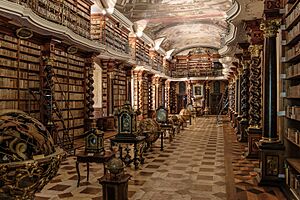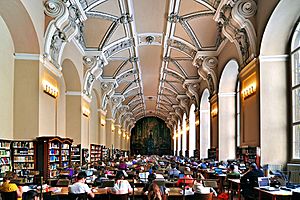National Library of the Czech Republic facts for kids
Quick facts for kids National Libraryof the Czech Republic |
|
|---|---|
 |
|
| Baroque library hall in the National Library of the Czech Republic | |
| Country | Czech Republic |
| Type | National library |
| Established | 1777 |
| Location | Clementinum, Prague |
| Coordinates | 50°5′14.62″N 14°25′2.58″E / 50.0873944°N 14.4173833°E |
| Collection | |
| Size | 7,727,350 total items (2023) 22,818 manuscripts c. 4,200 incunabula |
| Other information | |
| Director | Tomáš Foltýn |
The National Library of the Czech Republic (in Czech, Národní knihovna České republiky) is the main library for the entire Czech Republic. It is managed by the country's Ministry of Culture.
The library's main home is the historic Clementinum building in the heart of Prague. About half of its huge collection of books is kept there. The other half is stored in a different part of Prague, in an area called Hostivař. The National Library is the largest library in the Czech Republic. It holds around 6 million items, like books and other documents. Currently, more than 20,000 people are registered to use the library. Most of the texts are in Czech, but the library also has very old materials from countries like Turkey, Iran, and India. It also keeps books for Charles University in Prague.
Contents
History of the National Library
Early Beginnings in Prague
The story of the National Library began a long time ago, in the 1200s. A school called Studium generale was started in a Dominican monastery in Prague's Old Town. This school had its own library. In the 1300s, this school and its library joined with the university in Prague.
The Jesuits and the Clementinum
In 1556, a group of monks called the Jesuits built a new school called Clementinum. They built it where the old Dominican monastery used to be. From 1622 onwards, the Jesuits also took charge of Charles University. All their libraries were then moved into the Clementinum building.
When the Jesuits were no longer in charge in 1773, the university became a state-run institution. In 1777, the library was given a new name: "Imperial-Royal Public and University Library" by Maria Theresa, who was the ruler at the time. Even when the university later split into a Czech and a German university in 1882, the library stayed as one shared place.
Becoming the National Library
In 1918, the government of the newly formed Czechoslovakia took over the Public and University Library. A special library for Slavic texts, called the Slavonic Library, was started in 1924. It moved to the Clementinum in 1929 and is still a part of the National Library today.
In 1935, the library was renamed "National and University Library." In the same year, a law was introduced about "legal deposit copies." This meant that Prague printers had to give a copy of every book they printed to the library. This rule actually started even earlier, in 1781.
During the German occupation of Czechoslovakia in 1939, Czech universities were closed. However, the library stayed open under the name "Municipal and University Library."
In 1958, all the big libraries in Prague were combined into one large library called the State Library of the Czechoslovak Republic.
Finally, in 1990, the library got its current name: the National Library of the Czech Republic. A new building for storing books, called the Central Depository, opened in Hostivař in 1996.
Special Collections
The National Library has some very old and valuable handwritten books from the Middle Ages. Two of the most important ones are the Codex Vyssegradensis and the Passional of Abbes Kunigunde. These are truly special treasures!
Turning Books into Digital Copies
The National Library of the Czech Republic started turning its old books and documents into digital copies in 1992. They worked with a Czech company called AiP Beroun. The library was a leader in this field, helping to create the first rules for how to digitize old texts.
Later, the library joined many projects across Europe. They helped develop even more rules, especially for old handwritten books and early printed books. They also supported the very first projects for the UNESCO Memory of the World Programme. In fact, the National Library of the Czech Republic had the program's first pilot project in 1993.
In 2005, the library received an important award called the Jikji Prize from UNESCO. This was for their great work in digitizing old texts. In the first 13 years of the project, from 1992, they digitized 1,700 documents and made them available for everyone to see.
Online Digital Libraries
The National Library shares its digital content through two main online libraries: Manuscriptorium (http://www.manuscriptorium.com/en) and Kramerius (http://kramerius5.nkp.cz).
- Manuscriptorium has over 111,000 old handwritten books and early printed books. The National Library contributed almost 84,000 of these. The rest come from 138 partners in 24 different countries! Since 2008, Manuscriptorium has also shared these digital copies with Europeana. Europeana is a digital platform from the European Union that collects cultural heritage from all over Europe.
- The National Library also worked with Google to digitize more than 177,000 old printed books and books from the early 1800s from the Slavonic Library. You can find these books in the Google Books digital library. They are also in the National Library's own catalogs.
- The Kramerius digital library contains digital copies of documents published after the year 1800. So far, more than 2,000 series of newspapers and magazines have been digitized. The number of digitized books keeps growing, especially with a big project to digitize modern books.
Proposed New Building Plans
In 2006, the Czech parliament approved money to build a new library. It was planned for a place called Letná plain in Prague. In March 2007, a Czech architect named Jan Kaplický was chosen to design the building. It was supposed to be finished by 2011.
However, the project faced problems later in 2007. Some government officials, including the Prague Mayor and the President, did not like the proposed location. The plans for the building were still not decided in February 2008. Later in 2008, the Minister of Culture announced that the project was canceled.
Library Incidents
The library was affected by the big 2002 European floods. Some documents had to be moved to higher floors to protect them from the water. In July 2011, over 4,000 books were removed from the library because of flooding in parts of the main building. There was also a fire at the library in December 2012, but thankfully, no one was hurt.
See also
 In Spanish: Biblioteca Nacional de la República Checa para niños
In Spanish: Biblioteca Nacional de la República Checa para niños
- List of national and state libraries



